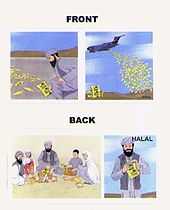Humanitarian daily ration

Humanitarian daily rations (HDRs) are food rations intended for humanitarian crises.[1][2] Each is intended to serve as a single person's full daily food supply, and contain somewhat over 2,200 calories. They have shelf-lives of about 3 years, and their contents are designed to be acceptable to a variety of religious and ethnic groups.
The rations were first used in Bosnia in 1993.[3]
The meals are designed to be able to survive being air-dropped, without a parachute.[4] This is safer for refugees than parachuting large pallets of rations, as well as preventing meal hoarding by individuals.[citation needed]
The meals cost approximately one-fifth of the cost of a meal ready to eat.[4]
HDRs are also made available through organizations such as The Salvation Army to aid victims of poverty in the United States, and were distributed during Hurricane Katrina and Hurricane Rita to victims of the disasters by the Federal Emergency Management Agency (FEMA).
Packaging and distribution


The HDR packages are delivered in cases of packages, each containing a small selection of food items based on predetermined menus and an accessory pack containing red pepper, pepper, salt, sugar, spoon, matches, an alcohol-free moist towelette, and a napkin.[5][6]
HDRs are typically air-dropped into the disaster area on large pallets. The HDRs initially dropped in Afghanistan were yellow before it was realized that the packages were the same color as the bomblets in American cluster bombs, which were also dropped in Afghanistan.[5][7] Later packages were made in an orange-pink color described as "salmon".[8]
Typical contents
- Main Entree, two of:
- Lentil or Barley Stew
- Yellow or Herb Rice
- Red Beans and Rice
- Beans and Rice with Tomato Sauce
- Peas in Tomato Sauce
- Beans with Potatoes
- Shortbread
- Fig bar
- Vegetable crackers
- Peanut Butter
- Strawberry Jam
- Fruit pastry (much like a Pop-tart)
- Accessory Pack containing:
- Book of matches (unprinted)
- Salt, pepper and sugar packets
- Packet of crushed red pepper
- Moist towelette (alcohol-free)
- Paper napkin
- Plastic spoon
Flameless ration heaters, found in MREs, are not included.
Specifications
| Shelf life | 36 months at 80 °F (27 °C) |
| Weight | 30 ounces (850 g) |
| Kilo Calories | at least 2200 per package |
| Protein content | 10-13 percent |
| Fat content | 27-30 percent |
| Carbohydrate content | 60 percent |
| Prohibited contents | Any animal products, except a limited amount of dairy products, below the limit that would cause a problem for a person with lactose intolerance. |
| Infant component | All rations contain a fruit paste, or pudding, suitable for feeding to infants |
| Utensils | All rations contain a spoon and a paper towel moistened with a non-toxic, non-alcoholic cleanser |
American Humanitarian Daily Ration program in Afghanistan
On October 15, 2001, The United States announced a Humanitarian daily ration for Afghanistan.[9]
On October 24, 2001 Rear Admiral John Stufflebeem announced fears that the Taliban planned to poison American food aid.[10] Stufflebeem said that since the program had been started on October 7, 2001 the USA had dropped 785,000 rations.
References
- ↑ 1.0 1.1 "TECHNICAL DATA FOR HUMANITARIAN DAILY RATION". United States Department of Defense. Retrieved 2007-10-18.
- ↑ Judith McCallum (Winter 2001). "Humanitarian Daily Rations: Being Ready is Half the Battle". Defense Security Cooperation Agency. Retrieved 2007-10-18.
- ↑ "MEMORANDUM FOR CORRESPONDENTS". United States Department of Defense. August 2, 1995. Retrieved 2007-10-18. "Hundreds of thousands of HDR's were first air-dropped over isolated Bosnian enclaves on November 22, 1993, as part of the humanitarian relief effort PROVIDE PROMISE. Since then, the food packets have fed thousands of refugees worldwide."
- ↑ 4.0 4.1 4.2 . "Humanitarian Daily Rations". DCSA. Retrieved 2012-04-14.
- ↑ 5.0 5.1 "Humanitarian Daily Rations (HDRs)". Retrieved 2007-07-26. mirror
- ↑ 6.0 6.1 "Operational Rations". United States Defense Logistics Agency. Retrieved 2007-10-18.
- ↑ Albin R. Majewski (Winter 2001). "The Alphabet Soup of Combat Rations". United States Army. Archived from the original on 2007-08-18. Retrieved 2007-10-18.
- ↑ Bill Dugan. "MICA Flex Studio 4th group". Retrieved 2007-07-26. mirror
- ↑ "Humanitarian Aid to the Afghan People: Issued by the Office of International Information Programs October 15, 2001". United States Department of State. October 15, 2001. Retrieved 2007-07-26.
- ↑ "Defense Dept. Says Taliban May Attempt to Poison Afghan Food Aid". United States Department of State. October 25, 2001. Retrieved 2007-07-26. mirror
External links
| Wikimedia Commons has media related to Humanitarian daily ration. |